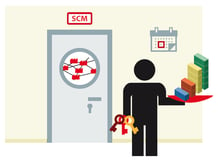The Top 5 KPIs Every Inventory Manager Should Track
Jesse Kelber - November 26, 2019

Is your boss starting to ask uncomfortable questions? Like what your average order cycle time is? Or what the latest shrinkage numbers are? Sounds like it’s time to line up your metrics and develop a solid plan for tracking and reporting to management.
No matter where your company stands on the digital transformation journey, there are key performance indicators (KPIs) that every inventory manager should have a handle on. These are the metrics that tell you how you’re doing in the broader picture of helping the company meet goals and maintain market share. They can also give you a leg up by giving you ideas for where you can make adjustments to proactively improve performance. We’ve picked our top 5 metrics that are independent of your level of adoption of Industry 4.0 technology to show that the power of metrics is in the numbers themselves. Technology like IoT sensors, RFID tags, and AI-powered advanced analytics take your supply chain to the next level, but you need to know where you’re starting from, and these are the KPIs that can give you that baseline.
1. Demand Forecast Accuracy
Topping our list is a KPI that isn’t actually one single metric, rather it’s an amalgam of several distinct numbers. Demand forecast accuracy is a combination of factors:
- Actual forecast accuracy (defined as the ratio of forecast to actual sales)
- Forecast error
- Mean average deviation (MAD)
- Mean percentage error (MPE)
- Mean absolute percentage error (MAPE)
It’s that last one that we want to focus on today. MAPE gives you the clearest idea of the actual accuracy of your forecasts because it looks at only the absolute difference between predicted and actual sales. The formula to calculate MAPE looks like this:
(Absolute value(actual-forecast)/actual) x 100
This one aspect of overall accuracy gives you a concrete number that will tell you how close your predictions come to reality. It also allows for easier aggregation when taking into account an overall average across SKUs (for example).
2. Lead Time (Order Cycle Time)
Lead time, or order cycle time, is a KPI that gives you a snapshot of how efficiently your order processing is working. Long lead times means there are likely bottlenecks or gaps somewhere along the way that need to be addressed. These extended lead times can lead to other costs skyrocketing as well, like storage costs (which we’ll be addressing momentarily), as you end up with product that is just sitting around taking up shelf space. Defined as the number of calendar days that pass while a product is in a given state, there is a small difference in the terms used. Lead time covers from when the product begins to be made through final delivery, while lead time includes the time from order to production beginning. Either is a great way to gauge efficiency. Tracking this metric can help nail down inefficiencies in the production line, warehousing, or logistics.
3. Shrinkage
Shrinkage is defined as the difference between actual stock on hand and what’s showing on paper. Otherwise known as the amount of product lost due to employee error, supplier fraud, or administrative mistakes. There are a couple of main reasons this made our top 5. First, how much fraud or theft is occurring within your supply chain can help determine the overall state of your business culture and areas of admin that need work. And second, shrinkage lets you know how much extra stock you need to be producing in order to maintain orders and meet demand without coming up short. It gives you the freedom that comes with a bit of wiggle room in terms of how much overage to produce without going overboard and ending up with extra supply sitting on the shelves.
4. Storage Costs
This KPI is useful in determining how much profit is available to be made from existing stock. Often described as a percentage of the value of all available stock, storage costs are calculated on the total cost of warehousing that stock. The calculation generally includes these factors:
- Warehouse space costs
- Employee costs
- Insurance costs
- Depreciation
This metric is important to have on hand when determining the bottom line boost you can achieve by streamlining existing processes and working to eliminate the need for storing merchandise for extended periods of time. As an inventory manager, there are a lot of savings to be found using this KPI as your benchmark. If you find a particular product is sitting around longer than any others, you have a starting point to look further into the inventory process for that SKU.
5. Perfect Order Performance
Our last entry is a high-level KPI, meaning that it’s a composite of inputs from across the value chain that when looked at in aggregate can give a snapshot of the overall health of the entire end-to-end supply chain. At a minimum, your POP should include the following measures:
- On-time delivery
- In-full delivery
- Correct invoice
The beauty of this metric is that it’s adjustable based on your specific needs. If there are logistics areas that you feel may be having a negative impact on your POP, including them in the calculation will give you the numbers you need to back up that assertion and gain the buy-in you need to begin having those issues addressed. Since POP cuts across departments, it also has the power to cut through information silos and is one of the simplest ways we know of to get an overall picture of your supply chain health.
No one KPI or metric can give you a 100% complete picture. They are each focused on one area of the supply chain or are at best aggregates that cover several areas in passing. These latter measures, like POP, are fantastic for obtaining a starting point for projects that aim to streamline processes and improve performance across the company. The power of these KPIs truly shines through when you combine all that you learn from studying your inventory metrics with what managers from other divisions up and down the chain learn from their own analyses. That’s when a cross-functional team can get to work finding ways to improve the numbers all along the supply chain and affect some real change on the company’s bottom line.
If you want to learn more get your Guide to Industry 4.0:
LATEST POSTS
- Understand Circular Economy in The Manufacturing Industry
- How Can Industry 4.0 IT Integration Be Achieved Smoothly?
- The Significance of Order Sequencing in Discrete Manufacturing
- How to improve your Supply Chain Management: The Power of Control Towers
- Optimizing Human Resource Scheduling in Manufacturing: A Technological Approach



